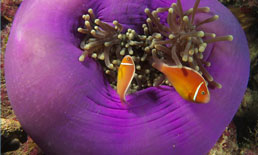- Box
Jellyfish
Species
- Chironex Fleckeri
- Given the name Sea Wasp
by an American author.
- There are many different
types but none are more venomous as the Indo-Pacific Box
Jellyfish. It is said to be the most venomous marine
animal. The box jellyfish is not found in the waters of
the Great Barrier Reef, it seems to move
towards the shoreline in calm waters when tide is
rising and gather near the mouths of rivers, estrays and
creeks following the rain.
-
- Stone
Fish
Species
- Synanceja
trachynis, Synaneichthyes verrucosus.
Other Names for the Stone
fish are Goblinfish, Rockfish.
- The stonefish lives
primarily above the tropic of Capricorn. Its main habitat
is on coral reefs,
near and about rocks, or can be found dormant in the mud
or sand.
-
- Cone
Shells
Species
- 80 Species in Australia
- Cone Shells or Cone
Snails as they are sometimes called, are
predatory gastropods.
It's venom can be fatal.
- Cone
snails are predatory gastropods that inhabit mostly
mud, sand flats shallow reef waters where the low and the
high tides alternate
-
- Stingrays
Species
- Over 35 species
- Stingrays are not usually
aggressive and will normally scurry away with the onset of
shuffling feet. Stingrays
live in warm and tropical areas. As the climate gets
cooler they move to deeper place Stingrays are not usually
aggressive. They rummage on the sea bottom and only attack
if they have been stepped on or threatened.
-
- Blue
Ringed Octopus
Species
- Hapalochaena
maculosa
- The venom from this little
creature can be fatal but only 11 cases had been reported
up to 1983, including 2 fatalities Blue Ringed Octopus are
mainly found in tidal rock pools around Australia.
